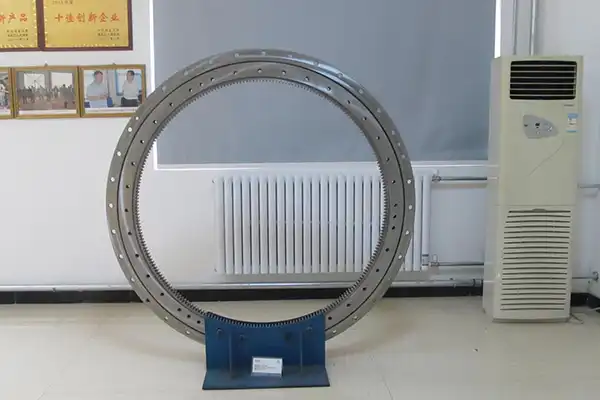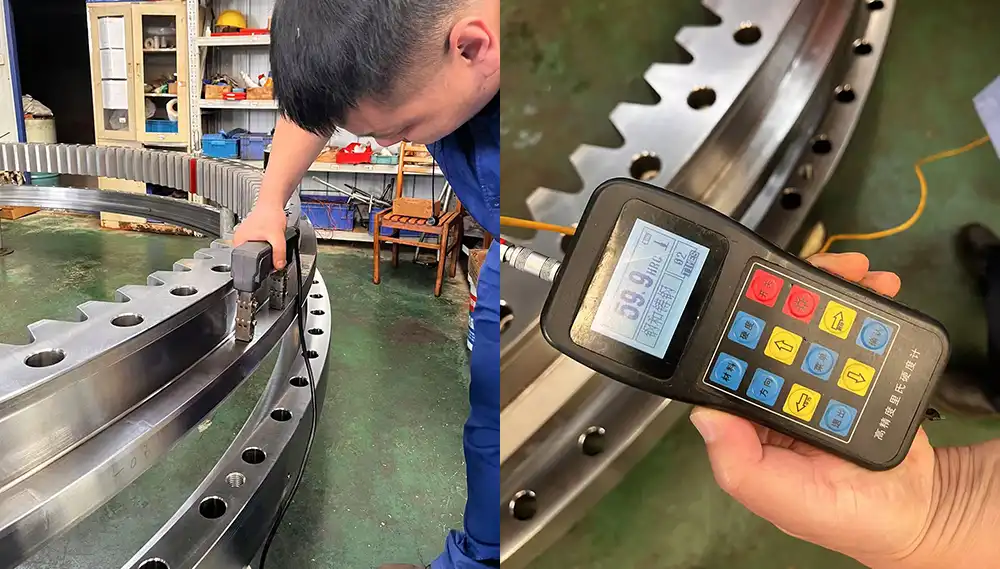What Materials Are Used to Manufacture Single Row Ball Slewing Bearings?
In the intricate world of mechanical engineering, single row ball slewing bearings stand as critical components that enable smooth rotational movement in countless industrial applications. These sophisticated mechanical devices play a pivotal role in supporting heavy loads while allowing precise rotation across various sectors, including construction, wind energy, maritime engineering, and industrial machinery. The manufacturing of these bearings involves a complex interplay of advanced materials, precision engineering, and metallurgical expertise, making them an fascinating subject of technological innovation.

What Are the Critical Material Considerations for Single Row Ball Slewing Bearings?
The manufacturing of single row ball slewing bearings represents a sophisticated process that demands extraordinary material selection and engineering precision. At the core of these remarkable components lies a carefully curated selection of materials that must withstand extreme mechanical stress, environmental challenges, and prolonged operational demands. High-grade steel alloys emerge as the primary material of choice, with each component meticulously designed to deliver optimal performance across diverse industrial landscapes.
The primary materials used in single row ball slewing bearings encompass a range of specialized steel alloys, each selected for its unique mechanical properties. Typically, manufacturers employ high-carbon chromium bearing steel, known scientifically as SUJ2 in Japanese industrial standards or AISI 52100 in American nomenclature. This particular steel alloy demonstrates exceptional characteristics that make it ideal for bearing manufacturing. The composition typically includes approximately 1% carbon and 1.5% chromium, which provides remarkable hardness, wear resistance, and fatigue strength.
The race rings of these bearings are predominantly manufactured using through-hardened bearing steel, which undergoes a precise heat treatment process to enhance its structural integrity. This treatment involves carefully controlled heating and cooling cycles that transform the steel's microstructure, creating a martensitic structure with superior hardness and wear resistance. The surface of these race rings is then ground to extremely tight tolerances, often within micrometers, ensuring perfect geometric precision that minimizes friction and maximizes operational efficiency.

Ball elements represent another crucial material consideration in single row ball slewing bearings. These spherical components are typically crafted from the same high-carbon chromium steel as the race rings, ensuring uniform material properties and compatibility. The manufacturing process involves precision grinding and heat treatment to achieve exceptional roundness and surface smoothness. Each ball is meticulously inspected to ensure it meets stringent quality standards, with surface roughness often measured in nanometers to guarantee optimal performance.
Supplementary materials also play significant roles in these complex mechanical systems. Sealing elements are frequently constructed from advanced synthetic rubber compounds or specialized polymers like nitrile (NBR) or fluoroelastomer (FKM), which provide exceptional resistance to environmental contaminants, temperature variations, and chemical interactions. These sealing materials prevent dust, moisture, and other potential contaminants from compromising the bearing's internal mechanisms.
The cage or separator mechanism, which maintains precise ball spacing and prevents direct contact between balls, is typically manufactured from brass, bronze alloys, or advanced polymer composites. These materials offer excellent sliding properties, low friction coefficients, and remarkable resistance to wear. In high-temperature or corrosive environments, specialized cage materials like polyamide-imide (PAI) or reinforced polymers might be employed to ensure sustained performance under extreme conditions.
How Do Material Choices Impact the Performance of Single Row Ball Slewing Bearings?
Material selection in single row ball slewing bearings transcends mere structural considerations; it fundamentally determines the bearing's overall performance, durability, and operational reliability. The intricate relationship between material composition, manufacturing techniques, and mechanical requirements creates a complex optimization challenge that engineers must navigate with exceptional precision.
The choice of high-carbon chromium bearing steel offers multiple advantages that directly influence bearing performance. The steel's inherent crystallographic structure provides exceptional load-bearing capabilities, with the ability to withstand significant radial and axial loads while maintaining minimal deformation. The chromium content enhances corrosion resistance, while the carbon component contributes to increased hardness and wear resistance.
Heat treatment processes represent another critical factor in material performance. Through carefully controlled thermal cycles, manufacturers can modify the steel's microstructure, creating a hardened surface layer with a more ductile core. This sophisticated approach ensures that the bearing can absorb shock loads while maintaining dimensional stability. The resulting case-hardened structure typically achieves surface hardness ranging between 58-64 HRC (Rockwell C scale), providing exceptional wear resistance without compromising the material's overall toughness.
Precision manufacturing techniques complement material selection, with advanced computer numerical control (CNC) machining and grinding processes ensuring microscopic tolerances. Modern manufacturing approaches employ statistical process control and sophisticated metrology techniques to verify material consistency and geometric precision. Coordinate measuring machines (CMM) can measure component dimensions with accuracy approaching one micrometer, ensuring that each bearing meets exacting engineering specifications.
The interaction between different material components within the bearing creates a complex tribological system where surface properties, lubrication, and mechanical loads intersect. Manufacturers must consider factors like hertzian contact stress, fatigue life prediction, and micropitting resistance when selecting and processing materials. Advanced computational models and finite element analysis help engineers simulate and optimize these intricate material interactions.
What Emerging Material Technologies Are Transforming Single Row Ball Slewing Bearings?
The landscape of material technologies for single row ball slewing bearings is continuously evolving, driven by demands for increased performance, reduced environmental impact, and enhanced operational efficiency. Emerging material innovations promise to revolutionize bearing design, offering unprecedented capabilities that were previously unimaginable.
Ceramic hybrid bearings represent one of the most exciting developments in bearing material technology. By replacing traditional steel balls with silicon nitride (Si3N4) ceramic balls, manufacturers can achieve significant performance improvements. Ceramic balls offer approximately 80% lower mass compared to steel, reducing centrifugal forces and enabling higher rotational speeds. Moreover, these advanced ceramic materials demonstrate exceptional hardness, corrosion resistance, and thermal stability.
Nanotechnology is progressively influencing bearing material development, with researchers exploring advanced surface treatments and coatings. Nanostructured coatings like diamond-like carbon (DLC) or advanced ceramic composites can dramatically reduce friction, enhance wear resistance, and extend operational life. These nanoscale interventions modify material surfaces at the atomic level, creating unprecedented performance characteristics.
Sustainable material alternatives are gaining prominence, with researchers investigating bio-based polymers and recycled metal composites for bearing components. These environmentally conscious approaches aim to reduce carbon footprints while maintaining rigorous performance standards. Advanced computational modeling and material science techniques enable the development of composite materials that challenge traditional steel-based designs.
Conclusion
The manufacturing of single row ball slewing bearings represents a remarkable confluence of material science, precision engineering, and technological innovation. From carefully selected high-carbon chromium steels to advanced ceramic and polymer technologies, these critical mechanical components embody human ingenuity in creating solutions that drive industrial progress.
Luoyang Huigong Bearing Technology Co., Ltd. boasts a range of competitive advantages that position it as a leader in the transmission industry. Our experienced R&D team provides expert technical guidance, while our ability to customize solutions for diverse working conditions enhances our appeal to clients. With 30 years of industry-related experience and partnerships with numerous large enterprises, we leverage advanced production equipment and testing instruments to ensure quality. Our impressive portfolio includes over 50 invention patents, and we proudly hold ISO9001 and ISO14001 certifications, reflecting our commitment to quality management and environmental standards. Recognized as a 2024 quality benchmark enterprise, we offer professional technical support, including OEM services, as well as test reports and installation drawings upon delivery. Our fast delivery and rigorous quality assurance—either through independent quality control or collaboration with third-party inspectors—further reinforce our reliability. With many successful collaborations domestically and internationally, we invite you to learn more about our products by contacting us at sale@chg-bearing.com or calling our hotline at +86-0379-65793878.
References
1. SKF Bearing Handbook, 2018 Edition
2. ASM International Materials Properties Database
3. International Journal of Mechanical Engineering and Robotics Research, Vol. 9, 2020
4. ASTM International Standards for Bearing Materials
5. Journal of Tribology, Special Issue on Advanced Bearing Technologies
6. Mechanical Engineering Magazine, Materials Innovation Section
7. International Conference on Advanced Manufacturing Technologies Proceedings
8. Materials Science and Engineering: A, Structural Materials Research
9. Bearing Technology Innovations - Springer Publication
10. Advanced Materials in Engineering Applications, CRC Press

